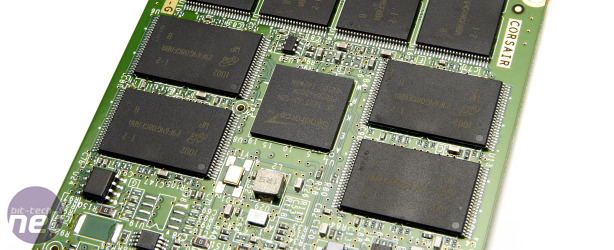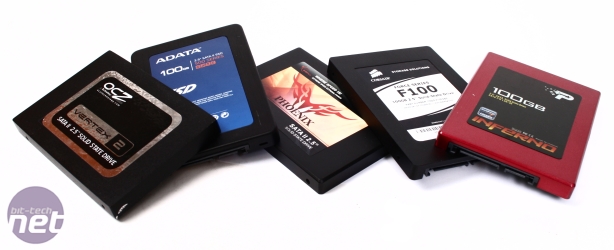
SandForce 100GB SSD Group test
It’s been a while since we’ve seen any kind of major advancement in SSD speeds, with drives powered by Indlinx controllers having been our choice for over a year. It’s not been all quiet though, with the introduction and widespread adoption of the TRIM command in that time ensuring drive performance doesn’t degrade over time. While this has caused plenty of confusion, the end result is a largely worry free array of drives that deliver on the promises of SSDs: amazing performance and absolutely no noise.The march of technology continues though, and the SSD market has received a major shakeup with the arrival of drives based around the new SandForce drive controller. We’ve got our hands on a 100GB SandForce drive from every major UK SSD manufacturer, so let’s find out what makes these drives tick.
SandForce – Under The Hood
SSDs that we’ve seen in the past have all been very similar in design, with a central drive controller, DRAM cache and then the array of NAND storage. In these designs, and as JMicron’s ill-fated JMF602 drive controller proved, the cache of an SSD is essential during heavy loads, especially when it comes to random write commands where an absence of cache results in stuttering, as the controller is overwhelmed with commands.The SandForce drive controller approaches things very differently though, by removing the need for a DRAM cache (although there is a buffer inside the controller itself). This is done thanks to the controller’s DuraWrite technology, working like lossless, on-the-fly data compression to significantly reduce the amount of data actually written by the drive. SandForce is predictably reluctant to discuss how this is done, with even its drive partners unable to give us many details.

Whether it's an SF-1500 or SF-1200 drive, the controller chip is identical.
The reason this compression technology is so important is the drive’s write amplification factor; where an SSD writes more data than it’s been given in order to correctly and tidily store the data on the drive. In the worst case,write amplification can be up to a factor of ten, so writing that 3MB MP3 file would require the SSD to write 30MB of data, with the SSD controller moving data around to optimise performance and the level of wear of each NAND storage cell.
In comparison, SandForce claims its algorithms deliver a write amplification factor of 0.5x – writing just 1.5MB of that 3MB file to the SSD, and with no loss of data. However, the controller will report that 3MB has been written so that the OS doesn’t get confused.
Not only does having to write less data allow SandForce controllers to perform incredibly quickly, but it also has the added bonus of massively reducing the wear on an SSD’s NAND storage. Up until now, SSD partners have been forced to use high quality NAND that can survive between 3,000 and 5,000 write/erase cycles in order to ensure their drives will last a reasonable amount of time.
By slashing the write amplification, SandForce SSDs don’t need to use the same high-quality and high-price NAND as their predecessors. While the drives on test today all use high-end NAND to keep the specs and MTBF (Mean Time Before Failure) high, we could see relatively cheap yet perfectly decent SandForce SSDs in the near future.
There are downsides to SandForce’s system though, most prominently the fact that when dealing with already heavily compressed or entirely random data, the drive’s performance drops due to its compression technology being unable to kick in. This introduces some variation in performance – if a game fully unpacks its textures and other data you’ll find a SandForce SSD to be very quick at loading levels, but if it only partially unpacks its files a SandForce SSD may not be noticeably faster than a decent Indilinx-powered drive.

MSI MPG Velox 100R Chassis Review
October 14 2021 | 15:04









Want to comment? Please log in.